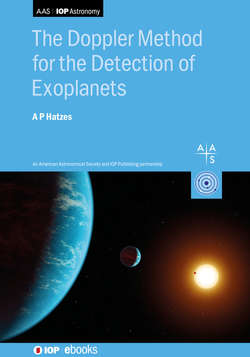Читать книгу The Doppler Method for the Detection of Exoplanets - Professor Artie Hatzes - Страница 12
На сайте Литреса книга снята с продажи.
1.3 Toward Precise Stellar Radial Velocity Measurements
ОглавлениеWith 150 years of stellar RV measurements and even proposals from the mid-20th century to build spectrographs capable of such precise measurements, why did it take until the end of the 20th century to discover the first exoplanets? The short answer: a lack of precision.
The Doppler shift of a star due to the presence of planetary companions is small. We can use Kepler’s third law to get an estimate of the RV precision needed to detect the reflex motion of star due to the presence of a planetary companion:
P2=4π2a3G(Ms+Mp),(1.1)
where Ms is the mass of the star, Mp is the mass of the planet, P the orbital period, and a the semimajor axis.
For planets, we are in the regime where Ms ≫ Mp. If we assume circular orbits and the fact that Mp × ap = Ms × as, where as and ap are the semimajor axes of the star and planet, respectively, it is trivial to derive
V[ms−1]=28.4P1yr−1/3MpsiniMJupMsM⊙−2/3,(1.2)
where i is the inclination of the orbital axis to the line of sight. Remember, the Doppler method only measures velocities along the line of sight.
The reflex motion of a 1 M⊙ star due to various planets at different orbital radii calculated with Equation (1.2) is shown Figure 1.3 and a Jupiter analog (1 MJup orbiting at a distance of 5.2 au) will induce a 11.2 m s−1 reflex motion of a Sun-like host star with an orbital period of 12 years. To detect such a planet, you would need an RV measurement precision of at least 10 m s−1, which would have to be maintained for over a decade.
Figure 1.3. The amplitude of the barycentric radial velocity variations for a 1 solar mass star orbited by an Earth, Neptune, Saturn, or Jupiter at various orbital distances.
Moving this planet to the semimajor axis of a “Struve planet” (0.02 au) would result in a reflex motion 10 times higher. This eases your required measurement precision to a more comfortable 100 m s−1 maintained over several days. If you are bold and you want to detect the first Earth analog (planet at 1 au), you would need a more challenging measurement precision of better than 10 cm s−1. For a “lava” Earth-mass planet orbiting at 0.05 au from the star, the stellar Doppler amplitude would be a more reasonable 1 m s−1, a precision, as we will soon see, that is achieved by modern instruments. This figure shows that to detect planets with the RV method, one needs exquisite precision coupled with long-term stability.
The early exoplanet surveys had a search strategy that was driven by the only example of a planetary system—our own. We thus expected giant planets to all lie at approximately 5 au from the star. The meant we required an instrument capable of achieving an RV measurement precision of at least 10 m s−1 and with a high premium on long-term stability.
Figure 1.4 demonstrates just why it took 150 years to discover exoplanets with the Doppler method. It shows the approximate RV precision as a function of time. The decrease in measurement error follows a power-law fit (solid line). In the 1960s, we could measure a star moving at the speed of an SR-71 military aircraft, or about a km s−1. Currently, we can measure a stellar RV under 1 m s−1, or the speed of a very leisure walk or a rapidly crawling baby. If the power law holds, we should achieve an RV precision of 10 cm s−1 by the mid-2020s. The “magic” precision of 10 m s−1, shown by horizontal dashed line, was only achieved in the mid-1980s. Coincidentally, this was about the time the first exoplanets were discovered.
Figure 1.4. The evolution of the radial velocity measurement error as a function of time. The horizontal line marks the reflex motion of a solar mass star with a Jupiter analog.
